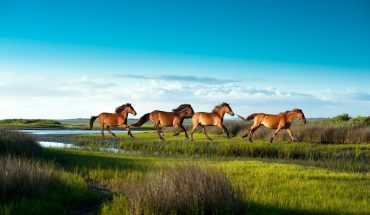When Scott Huler started researching the way his house fit into the surrounding city, he expected to find old deeds and dry records. Instead, the author found a dynamic adventurer from the 1700s—and his next project.
by Shelbi Polk
Author and journalist Scott Huler’s last book, On the Grid, broke down all the systems it takes to be part of a modern community, including water, sewage and electricity. And it was in the course of that research that Huler came across the writings of John Lawson, a self-funded adventurer and amateur scientist who visited the Triangle area in the 1700s. Lawson, who Huler says should be considered our state’s William Penn, quickly became the inspiration for Huler’s latest book, A Delicious Country (you may have read about in our pages a few years ago as he started writing it).
Lawson followed local people along trading routes from Charleston to the Pamlico Sound, sent samples of native flora and fauna back to London, and took detailed notes on the geography and people of the region. Along the way, Lawson helped found two of North Carolina’s first incorporated cities, Bath and New Bern.
Lawson’s book, A New Voyage to Carolina, allowed Huler to connect his home to an earlier time. Huler decided to take that connection a step further and trace Lawson’s journey through today’s Carolinas to write his own book about the region, A Delicious Country.
“So now when someone says ‘Where’s the book connecting Lawson’s observations to modern observations,’ they can say ‘Oh yeah you mean A Delicious Country,’” Huler said.
We don’t know exactly why Lawson left London to trek through the Carolina colony (at the time, there was only one large Carolina), but Huler thinks Lawson was simply excited by the spirit of discovery of the time.
Unlike many of his contemporaries, Lawson didn’t imagine he was showing up to explore an empty landscape. He actually worked to learn about the history and culture of the people already living there, instead of imposing his own ideas of civilization.
Lawson certainly wasn’t perfect. He was happy to buy land on his own terms and develop it as he saw fit. But he was one of the first Europeans to treat Native Americans like full humans, advocating intermarriage and calling out the supposedly Christian settlers on their cruelty.
Huler met many descendants of the people Lawson met in his own time, including the vice-chief of the Santee tribe in South Carolina. She told Huler that Lawson’s book, which included stories of her ancestors, had given her back her history.
When Lawson traveled through what would one day be our state, he saw Native American tribes struggling to maintain their way of life despite the arrival of European colonists.
“I would say that I walked through an almost amazingly parallel moment to Lawson’s moment,” Huler said.
Lawson realized the devastation the native people were facing, noting that he imagined there must have been six times as many Native Americans in the area just 50 years ago.
“Lawson walked through on this sort of knife-edge of a moment, where the past was just gone and the future was unpredictable,” Huler said. “He understood that he was seeing the devastated remnant of a once-thriving culture.”
And today? Huler also saw towns that were thriving even 30 years ago, struggling to adapt to today’s economic environment.
“I walked through little towns throughout North and South Carolina that are in the exact same situation,” Huler said, referencing the loss of industries like small farming businesses and furniture factories. “Everything has changed.”
One thing that hasn’t changed since Lawson’s time, Huler said, was that the people he met on Lawson’s route were “unfailingly kind.”
Huler kept a blog during his trip and posted a steady stream of photos to Instagram. Those photos, along with artifacts from Huler’s trip, are currently on display at the City of Raleigh Museum.







